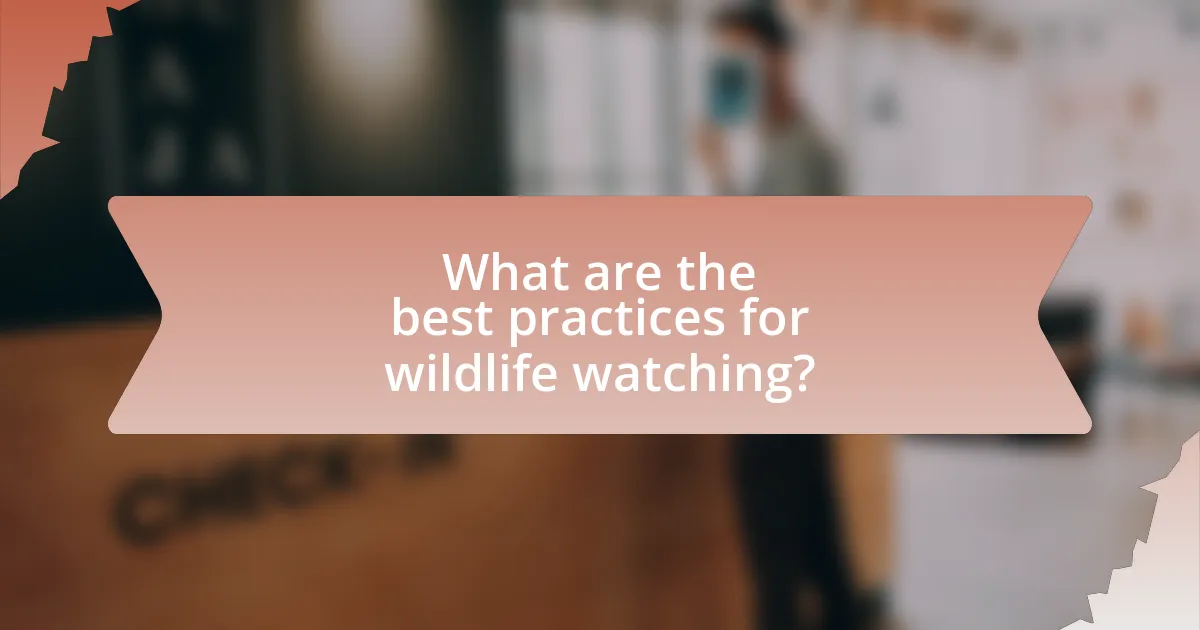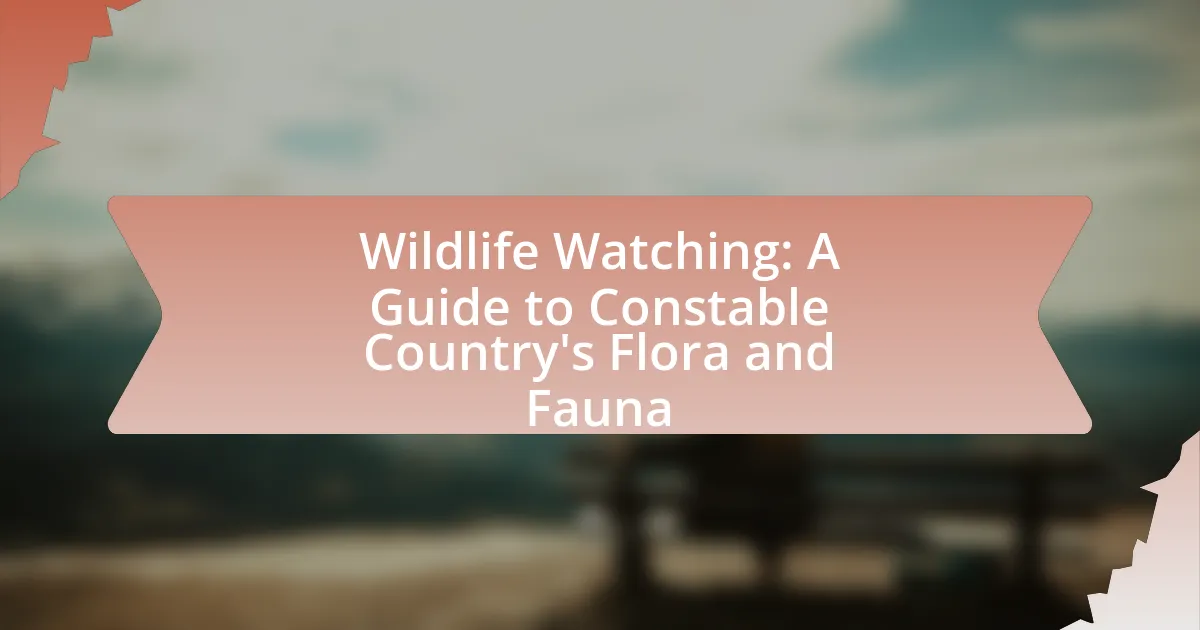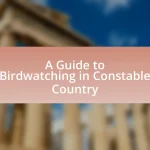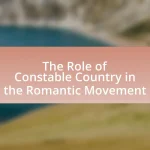Wildlife watching in Constable Country focuses on observing the region’s diverse flora and fauna, characterized by its wetlands, woodlands, and rich biodiversity. This area is home to various species, including rare birds like the bittern and marsh harrier, as well as common mammals such as deer and foxes. The article outlines the unique ecosystems present, the types of flora and fauna that can be observed, and best practices for wildlife watching, including preparation tips and ethical considerations. Additionally, it highlights resources available for wildlife enthusiasts, such as guided tours and local conservation organizations, to enhance the wildlife watching experience while promoting environmental stewardship.

What is Wildlife Watching in Constable Country?
Wildlife watching in Constable Country involves observing and appreciating the diverse flora and fauna in this picturesque region of England. This area, known for its stunning landscapes and rich biodiversity, offers opportunities to see various species, including birds, mammals, and unique plant life. The region’s natural habitats, such as wetlands and woodlands, support a wide range of wildlife, making it an ideal destination for nature enthusiasts.
Why is Constable Country a prime location for wildlife watching?
Constable Country is a prime location for wildlife watching due to its diverse habitats and rich biodiversity. The area features a mix of wetlands, woodlands, and meadows, which support various species, including birds, mammals, and insects. For instance, the presence of the River Stour creates ideal conditions for waterfowl and other aquatic wildlife. Additionally, the region is known for its population of rare species, such as the bittern and the marsh harrier, which thrive in the local marshlands. These factors contribute to Constable Country’s reputation as a significant site for observing wildlife in their natural environment.
What unique ecosystems are found in Constable Country?
Constable Country features unique ecosystems such as wetlands, ancient woodlands, and river valleys. These ecosystems support diverse flora and fauna, including rare species like the bittern and various orchids. The wetlands, for instance, provide critical habitats for migratory birds and aquatic life, while the ancient woodlands are home to a variety of tree species and wildlife, contributing to the area’s ecological richness.
How does the landscape influence wildlife diversity?
The landscape significantly influences wildlife diversity by providing varied habitats that support different species. Diverse landscapes, such as forests, wetlands, grasslands, and mountains, create unique ecological niches that cater to the specific needs of various organisms. For instance, the presence of water bodies in a landscape can attract amphibians and birds, while dense vegetation may support mammals and insects. Research indicates that areas with higher habitat heterogeneity, such as those found in Constable Country, tend to have greater species richness due to the availability of multiple resources and microhabitats. This ecological principle is supported by studies showing that regions with diverse landscapes can sustain a wider array of wildlife, enhancing overall biodiversity.
What types of flora and fauna can be observed in Constable Country?
Constable Country features a diverse range of flora and fauna, including ancient woodlands, wetlands, and grasslands. The area is home to species such as oak, ash, and hornbeam trees, alongside wildflowers like bluebells and primroses. Fauna includes notable species such as the barn owl, kingfisher, and various butterflies, including the common blue and the red admiral. The presence of these species is supported by the region’s varied habitats, which provide essential resources for wildlife.
What are the most common species of plants in the area?
The most common species of plants in Constable Country include oak, ash, and hornbeam trees, as well as various wildflowers such as bluebells and primroses. These species thrive in the region’s diverse habitats, which range from woodlands to meadows. The presence of these plants is supported by ecological studies that highlight their prevalence in the area, contributing to the rich biodiversity that attracts wildlife enthusiasts.
Which animals are frequently spotted by wildlife watchers?
Wildlife watchers frequently spot deer, foxes, badgers, and various bird species such as herons and kingfishers. These animals are commonly found in habitats like woodlands, wetlands, and grasslands, which are prevalent in Constable Country. The presence of these species is supported by ecological studies indicating their abundance in these environments, making them popular among wildlife enthusiasts.
How can one prepare for a wildlife watching experience in Constable Country?
To prepare for a wildlife watching experience in Constable Country, one should research the local flora and fauna, plan visits during optimal times for wildlife activity, and equip themselves with appropriate gear. Researching local species, such as birds and mammals, enhances the experience by allowing for better identification and appreciation. Optimal times for wildlife activity typically include early mornings and late afternoons when animals are most active. Essential gear includes binoculars for birdwatching, a field guide for species identification, and weather-appropriate clothing to ensure comfort during the outing.
What essential gear should wildlife watchers bring?
Wildlife watchers should bring binoculars, a field guide, a camera, appropriate clothing, and a notebook. Binoculars enhance the viewing experience by allowing observers to see distant animals clearly, while a field guide helps identify various species encountered in Constable Country. A camera captures memorable moments and wildlife behavior, and appropriate clothing, such as weather-resistant gear, ensures comfort during outdoor excursions. Finally, a notebook allows watchers to record observations and reflections, contributing to their understanding of local flora and fauna.
How can one enhance their chances of spotting wildlife?
To enhance chances of spotting wildlife, individuals should focus on being quiet and patient while observing natural habitats. Research indicates that many animals are sensitive to noise and movement, making stealth crucial for successful wildlife observation. Additionally, visiting during early morning or late evening increases the likelihood of encounters, as many species are more active during these times. According to the National Park Service, wildlife is often more visible during dawn and dusk due to their natural behaviors. Using binoculars or spotting scopes can also improve visibility without disturbing the animals, allowing for closer observation from a distance.

What are the best practices for wildlife watching?
The best practices for wildlife watching include maintaining a respectful distance from animals, minimizing noise, and avoiding feeding wildlife. Respecting distance is crucial as it prevents stress to animals and ensures their natural behavior is not disrupted; for example, approaching too closely can lead to flight responses or aggression. Minimizing noise helps to avoid startling animals, allowing for more natural observation. Additionally, feeding wildlife can alter their natural foraging behavior and lead to dependency on human food sources, which is detrimental to their health. Following these practices enhances the experience while promoting conservation and animal welfare.
How can wildlife watchers minimize their impact on the environment?
Wildlife watchers can minimize their impact on the environment by adhering to the principles of Leave No Trace, which emphasizes respecting wildlife and their habitats. This includes maintaining a safe distance from animals to avoid causing stress, staying on designated trails to prevent habitat destruction, and not feeding wildlife, as it can disrupt their natural foraging behavior. Research indicates that human disturbances can lead to significant changes in animal behavior and habitat use, highlighting the importance of these practices for conservation efforts.
What guidelines should be followed to ensure safety for both wildlife and watchers?
To ensure safety for both wildlife and watchers, maintain a respectful distance from animals, ideally at least 100 yards from large mammals and 25 yards from smaller wildlife. This distance minimizes stress on animals and reduces the risk of dangerous encounters. Additionally, avoid feeding wildlife, as it can lead to dependency on human food and alter natural behaviors. Following local regulations and guidelines, such as designated viewing areas and seasonal restrictions, further protects both wildlife and observers. Research indicates that disturbances from human interactions can negatively impact animal health and behavior, emphasizing the importance of these guidelines.
Why is it important to respect wildlife habitats?
Respecting wildlife habitats is crucial for maintaining biodiversity and ecosystem health. Healthy habitats support a variety of species, which in turn contribute to ecological balance and resilience. For instance, according to the World Wildlife Fund, approximately 1 million species are at risk of extinction due to habitat loss, highlighting the direct correlation between habitat preservation and species survival. Additionally, intact ecosystems provide essential services such as clean air and water, pollination of crops, and climate regulation, which are vital for human well-being. Therefore, respecting wildlife habitats is essential for sustaining both wildlife and human populations.
What ethical considerations should wildlife watchers keep in mind?
Wildlife watchers should prioritize minimizing disturbance to animals and their habitats. This includes maintaining a safe distance from wildlife to avoid causing stress or altering their natural behaviors. Research indicates that close encounters can lead to negative impacts on animal health and reproduction, as documented in studies on wildlife stress responses. Additionally, wildlife watchers should adhere to local regulations and guidelines, which are designed to protect both the animals and the environment. Respecting these rules helps ensure sustainable wildlife viewing experiences and preserves ecosystems for future generations.
How can one avoid disturbing animals during observation?
To avoid disturbing animals during observation, one should maintain a safe distance and minimize noise. Keeping a distance of at least 100 meters from wildlife helps prevent stress and disruption to their natural behaviors. Additionally, using binoculars or a camera with a zoom lens allows for close observation without physical proximity. Research indicates that loud noises can cause animals to flee or alter their behavior, so speaking softly and avoiding sudden movements is crucial. Following these practices ensures a respectful and non-intrusive wildlife watching experience.
What are the consequences of irresponsible wildlife watching?
Irresponsible wildlife watching can lead to significant negative consequences for both wildlife and ecosystems. Disturbance to animals can result in stress, altered behaviors, and even abandonment of nests or young, which can threaten species survival. For instance, research indicates that human presence can cause wildlife to flee from their habitats, leading to decreased reproductive success and increased mortality rates. Additionally, irresponsible practices such as feeding wildlife can create dependency on human food sources, disrupting natural foraging behaviors and leading to health issues in animals. Furthermore, habitat degradation occurs when observers trample vegetation or disturb sensitive areas, which can result in long-term ecological damage.

What resources are available for wildlife watching in Constable Country?
Resources for wildlife watching in Constable Country include guided tours, nature reserves, and local wildlife organizations. Guided tours, such as those offered by the National Trust, provide expert insights into the area’s diverse species and habitats. Nature reserves like the Dedham Vale AONB (Area of Outstanding Natural Beauty) offer designated areas for observing wildlife in their natural settings. Additionally, local wildlife organizations, such as the Essex Wildlife Trust, provide educational materials and events that enhance the wildlife watching experience. These resources collectively support wildlife enthusiasts in exploring and appreciating the rich biodiversity of Constable Country.
Where can one find guided tours or local experts?
Guided tours and local experts can be found through various platforms such as tourism websites, local visitor centers, and specialized wildlife organizations. For instance, the official tourism website for Constable Country often lists guided tours led by knowledgeable local experts who focus on the area’s unique flora and fauna. Additionally, organizations like the RSPB (Royal Society for the Protection of Birds) provide expert-led wildlife watching events and tours, ensuring participants gain insights from experienced guides. These resources are reliable for connecting with professionals who have in-depth knowledge of the region’s wildlife.
What online resources provide information about wildlife in Constable Country?
Online resources that provide information about wildlife in Constable Country include the official websites of the National Trust and the RSPB (Royal Society for the Protection of Birds). The National Trust offers detailed insights into the area’s natural habitats and species, while the RSPB focuses on birdwatching opportunities and conservation efforts specific to the region. Additionally, local wildlife trusts, such as the Suffolk Wildlife Trust, provide educational resources and information on local wildlife events and conservation projects. These organizations are credible sources for accurate and up-to-date information on the flora and fauna of Constable Country.
How can local conservation organizations assist wildlife watchers?
Local conservation organizations assist wildlife watchers by providing educational resources, organizing guided tours, and facilitating habitat preservation efforts. These organizations often offer workshops and informational materials that enhance the understanding of local species and ecosystems, which enriches the wildlife watching experience. For instance, organizations like the RSPB (Royal Society for the Protection of Birds) conduct field trips that allow wildlife watchers to observe birds in their natural habitats while learning about their behaviors and conservation status. Additionally, conservation groups actively work to protect and restore habitats, ensuring that wildlife populations remain healthy and accessible for observation. This dual approach of education and habitat conservation directly supports the interests of wildlife watchers, fostering a deeper connection to nature and promoting sustainable practices.
What tips can enhance the wildlife watching experience?
To enhance the wildlife watching experience, individuals should prioritize early morning or late afternoon outings, as these times are when many animals are most active. Research indicates that animals tend to be more visible during these periods due to lower temperatures and increased feeding activity. Additionally, maintaining silence and minimizing movement can significantly improve the chances of observing wildlife, as many species are sensitive to noise and sudden motions. Using binoculars or a camera with a zoom lens allows for closer observation without disturbing the animals, further enriching the experience. Lastly, familiarizing oneself with local species and their behaviors can lead to more successful sightings, as understanding patterns of activity increases the likelihood of encounters.
How can one effectively use binoculars or cameras for wildlife observation?
To effectively use binoculars or cameras for wildlife observation, one should ensure proper equipment handling and optimal settings. For binoculars, adjust the focus and interpupillary distance to match your eyes, and hold them steady to avoid blurriness. For cameras, use a fast shutter speed to capture moving animals and set the appropriate ISO for lighting conditions. Additionally, employing a tripod can stabilize the camera for clearer images. Research indicates that using binoculars can enhance the viewing experience by allowing observers to see details from a distance, while cameras enable documentation of wildlife behavior and habitat.
What time of day is best for wildlife watching in Constable Country?
The best time of day for wildlife watching in Constable Country is early morning and late afternoon. During these times, animals are most active, making it easier to observe them. Studies indicate that many species, including birds and mammals, exhibit increased foraging and movement during dawn and dusk, known as crepuscular behavior. This pattern is particularly evident in areas with diverse habitats like Constable Country, where the combination of light and temperature influences animal activity levels.


